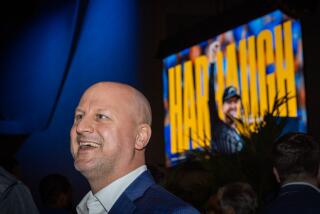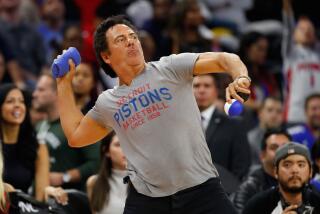Barron Hilton, who led hotel chain and founded the L.A. Chargers, dies at 91
- Share via
Barron Hilton loved playing poker, flying — in both conventional aircraft and sailplanes — and owning an upstart pro football team in an upstart league, but when it came to seeking his fortune, he chose the family business, the Hilton Hotel Corp.
Wise choice, as it turned out, for Hilton, who was more than financially able to indulge his passions — his annual weeklong “soaring camp” at his Nevada ranch was considered a “must do” by sailplane enthusiasts around the world — the business, and, ultimately, the Conrad Hilton Foundation.
Hilton, who died Thursday of natural causes at his home in Los Angeles, in his 30 years as chief executive officer built the Hilton brand into the best known, most successful and most respected name in the industry. When it finally was sold in 2007, the Blackstone Group paid $26 billion for 2,800 hotels with 480,000 rooms in 76 countries.
That same year, Hilton announced that he would leave about 97% of his estate, estimated then to be worth $2.3 billion, to the Hilton Foundation, an international charitable organization begun by his father, Conrad Hilton, the family patriarch and founder of the hotel chain.
“The Hilton family mourns the loss of a remarkable man,” said son Steven M. Hilton, chairman of the Hilton Foundation. “He lived a life of great adventure and exceptional accomplishment.”
William Barron Hilton — Barron was his mother’s maiden name — was born Oct. 23, 1927, in Dallas, where he grew up as a devoted fan of the planes that flew into and out of Love Field, the city airport. He had his flying license by the time he was 17 and was serving as a Navy photographer during World War II. And he wasn’t particularly fond of the hotel business.
After the war, at 19, he told his father that he would go to work for the company for $1,000 a month. His father said no thanks, so the young Barron left and didn’t come back until more than a decade later, by which time he was a millionaire.
“I guess you could say that I wanted to make it on my own,” Hilton said in an interview with the Miami Herald in 1982.
He began by peddling orange juice products with several partners in Southern California but soon bought them out and had the distributorship to himself. He co-founded an oil company, then started one of the first aircraft-leasing businesses in the country.
But in 1951, when he returned to Hilton Hotels, he started in the operations department, at the bottom of the corporate ladder. Showing his business talent, he quickly moved up and by 1954 was vice president, in charge of the company’s new venture, Carte Blanche, one of the first credit cards.
That venture didn’t go so well, losing $2 million in six years, so Hilton sold the brand to Citibank and, using his own money, moved on to one that turned out quite well indeed, the Los Angeles Chargers.
Texas oil magnates Lamar Hunt and Bud Adams had been turned down for expansion franchises by the National Football League in 1959, just as that pro football league was emerging as the country’s strongest sports organization. They decided that if you can’t join them, fight them, so they contacted other wealthy and influential businessmen to form a new eight-team league. They dubbed themselves “The Foolish Club” for so brazenly challenging the mighty NFL.
Hilton was invited to put a team in Los Angeles, which already had a solid NFL team with a substantial following in the Rams, but he quickly decided that there was room for two in L.A. So when the American Football League began its first season in the fall of 1960, the Los Angeles Chargers, coached by the legendary Sid Gillman, with future New York Rep. Jack Kemp at quarterback, were ready for battle, along with the New York Titans (now the Jets), the Buffalo Bills, the Boston (New England) Patriots, the Denver Broncos, the Dallas Texans (Kansas City Chiefs), the Houston Oilers (Tennessee Titans) and the Oakland Raiders.
The team was named Chargers in a contest among fans, although it was commonly assumed that the name was a takeoff on the Carte Blanche card.
“It was after the trumpet call, followed by the roar of ‘Charge!’” Hilton told Bill Dwyre of The Times in 2009. “It never had a thing to do with the credit card.”
Hilton also instigated the lightning bolts on the team’s helmets. “I have a passion for flying and that’s why I wanted the bolt,” he said.
Things went well for the Chargers on the field, where they went 10-4 and lost to the Oilers and Billy Cannon in the inaugural league championship game, but not so well at the gate. The Rams customarily drew 50,000 or more to their games at the Coliseum, the Chargers considerably fewer.
“We were averaging 13,000-14,000 people and that looked pretty ugly in the Coliseum,” Hilton said.
So, in response to a public campaign led by Sports Editor Jack Murphy of the San Diego Union newspaper, Hilton moved the team south. It continued to flourish in San Diego and in the six seasons he owned the Chargers, they won five Western Division titles and the 1963 AFL championship. And the league, with its wide-open style of play, its national TV contract and its growing ability to sign the best college players — the Chargers signed All-American Kansas quarterback John Hadl under the goal posts immediately after the Bluebonnet Bowl game — was giving the NFL fits.
“The happiest days of my life were the days I was involved with the Chargers,” Hilton said.
Hilton, as league president in 1965, also helped negotiate the eventual merger of the AFL with the NFL, all eight AFL teams making the move in a deal announced in 1966 that eventually produced the Super Bowl, which was held at the Coliseum the following year.
“From the start, we had hoped at some point that we’d have a merger,” Hilton recalled. “But we also wanted a successful league, and we got that.”
By then, though, Dad and duty were calling. Conrad wanted him to ditch the Chargers and take over the business, so in 1966 he sold his controlling interest in the team for a then-record $10 million — his original investment had been $25,000 — and succeeded his father as president and CEO of the Hilton Corp.
The company had already, at Barron’s urging, spun off the international operation — it was repurchased years later — and he had other changes in mind.
Biggest among them was Hilton’s move into gaming with the purchase of two Las Vegas casinos, the Flamingo and the International. Within months, gambling revenue was accounting for about 40% of company profits, with more hotel/casinos on the horizon.
Hilton personally came up with two innovations that quickly became standard in casinos everywhere. He replaced the human “eye in the sky” security observers with video cameras, and introduced progressive slot machines that occasionally yielded record jackpots, generating lots of free publicity.
Hilton also was among the first to use management leaseback deals. In 1975, he sold half of the company’s equity in six major hotels but continued managing the properties for a percentage of room revenue and gross profits. That deal brought in $83 million, which was used to buy back Hilton stock, which ultimately increased seven times in value. Eventually, growth in the hotel end of the business came mostly from other leaseback arrangements and franchise deals.
Not everything he touched turned to gold, though. In 1985, the New Jersey Casino Control Commission denied his request for a gaming license after he had already built a $320-million casino in Atlantic City. The commission cited Hilton’s 13-year relationship with Sidney Korshak, a Chicago labor lawyer with alleged ties to organized crime. Hilton sold the new property to Donald Trump, ended his business relationship with Korshak and was finally awarded a New Jersey license in 1991.
There was a flap, too, after Conrad’s death in 1979. The elder Hilton left most of his fortune, 13.5 million shares of Hilton stock, to his foundation, which at that time was used mostly to help Catholic nuns. Tax law would have forced the foundation to sell much of the stock, leaving the company open to a hostile takeover. Hilton went to court, claiming that his father never intended to jeopardize family control of the company and that his father’s will gave him the option to buy the foundation’s stake at $24 a share.
The legal battle went on for 10 years, until a settlement in 1989 gave 4 million shares to Hilton, 3.5 million shares to the foundation, and 6 million shares to a trust, with Hilton as executor, which would revert to the foundation in 2008.
“It was a very painful decade,” Hilton told USA Today in 1995. “Hilton vs. the nuns was not the best public relations move.”
Hilton was married to Marilyn Hawley for 57 years until her death in 2004. He is survived by children William Barron Jr., Hawley McAuliffe, Steven, David, Sharon Constance Hilton, Richard, Daniel and Ronald; 15 grandchildren, including Paris and Nicky Hilton Rothschild; and four great-grandchildren.
Kupper is a former Times staff writer.
More to Read
Start your day right
Sign up for Essential California for the L.A. Times biggest news, features and recommendations in your inbox six days a week.
You may occasionally receive promotional content from the Los Angeles Times.






